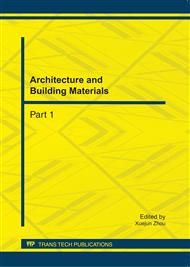p.800
p.804
p.810
p.815
p.821
p.826
p.832
p.838
p.842
Research on the Treatment for Water Damage to Widened Subgrade of Collapsible Loess Based on Centrifuge
Abstract:
A centrifugal earth structure deformation test system has been developed to study the mechanism and pattern of subgrade damage as caused by water wetting to the widened roads in collapsible loess areas. It incorporates an upgraded electric sensor logging system and a centrifugal field image pickup system and provides a centrifuge model test platform for both the new road and the original road that are subject to water wetting and infiltration. A centrifuge test model on which actual stress distribution can be simulated was set up to study the forms of water damage to the widened subgrade. In the same time, special research was conducted with regard to the working mechanism of geogrid in the splice between the new road and the old, as well as the effect of dynamic compaction on loess foundation. It indicates that high water content in the toe of slope of a widened road could significantly influence the stability of subgrade. Local instability in loess foundation, as caused by the presence of high level of underground water especially after a heavy rain, could be a great threat to the integrity and safety of the subgrade on top of it. In this case the loess foundation, which is locally wetted and softened by water, would undergo a reduction in shearing strength and gradually lose its stability under the load of subgrade, that eventually results in the sliding or separation between the new subgrade and the old. The reinforced materials used in the splice can enhance soil hardening and help establish soil arching effect under which the settlement of subgrade is well controlled.
Info:
Periodical:
Pages:
821-825
Citation:
Online since:
September 2011
Authors:
Keywords:
Price:
Сopyright:
© 2011 Trans Tech Publications Ltd. All Rights Reserved
Share:
Citation:


